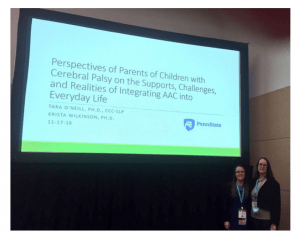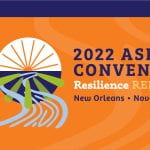 O’Neill, T., & Wilkinson, K. (2018, November). Designing AAC technologies to fit into family life: Perspectives of parents. Presentation at the American Speech-Language-Hearing Association (ASHA) Conference, Boston, MA.
O’Neill, T., & Wilkinson, K. (2018, November). Designing AAC technologies to fit into family life: Perspectives of parents. Presentation at the American Speech-Language-Hearing Association (ASHA) Conference, Boston, MA.
O’Neill & Wilkinson (2018) Handout (pdf)
Abstract: In order to ensure long-term adoption and use of augmentative and alternative communication (AAC) technologies, they must be designed to support children to participate within everyday activities and routines that are prioritized by families. Nine parents of children with cerebral palsy who used AAC technologies participated in semi-structured interviews to provide their perspectives of how AAC technologies were integrated into the functional contexts of everyday life.
Five major themes emerged from the discussions:
- integrating AAC into life;
- AAC technologies;
- child needs and skills;
- parent responsibilities and priorities; and
- AAC process and decision making
Children were able to use AAC technologies within a variety of everyday contexts with various partners; however, challenges included access to AAC within physical and outdoor activities and partners who lacked knowledge regarding operational competencies and effective interaction strategies. In order to integrate AAC technologies into life, parents prioritized technology features including ease of programming, improved physical design (e.g., lighter, wearable, easy to mount, durable), features to enhance efficiency and ease of access (e.g., brain-computer interface, sentence prediction), and availably of multiple functions and features (e.g., facial recognition software, augmented reality, projection capabilities, capability to control wheelchair). AAC manufacturers and mainstream technology developers should work to ensure that technologies are responsive to the supports, limitations, and ideal features identified by parents. Future research should seek input from a larger group of stakeholders and use longitudinal methods to examine perceptions of AAC technologies over time.
All ASHA 2018 presentations by students and faculty can be found here.

